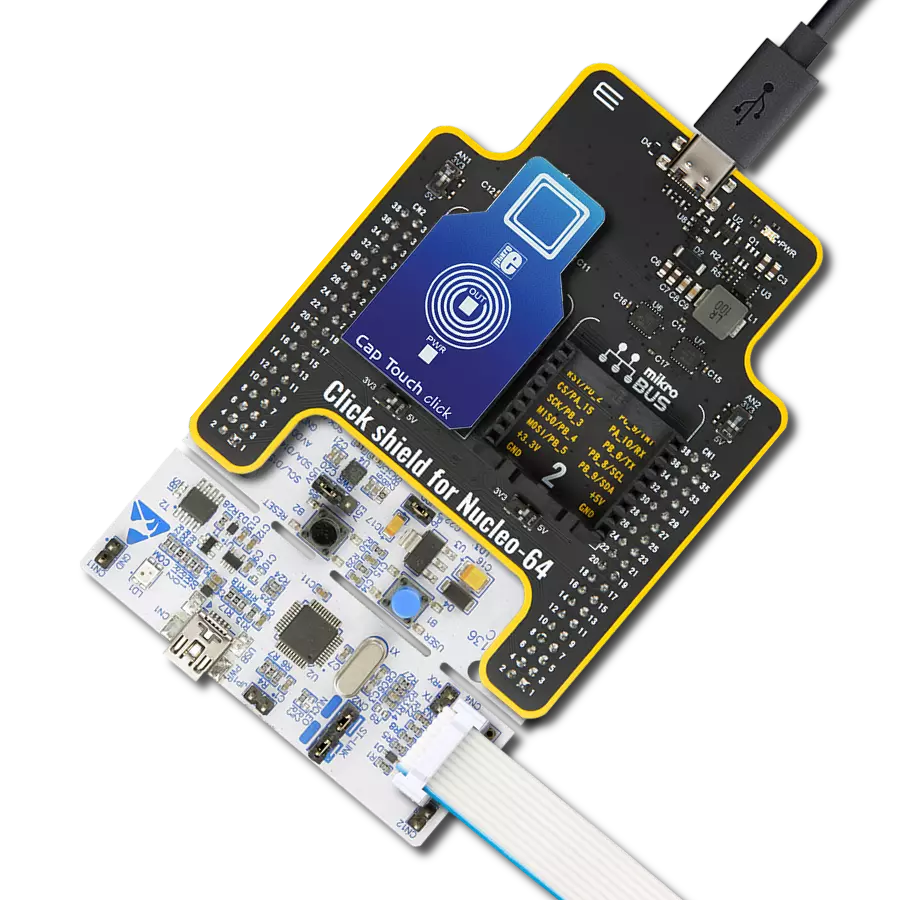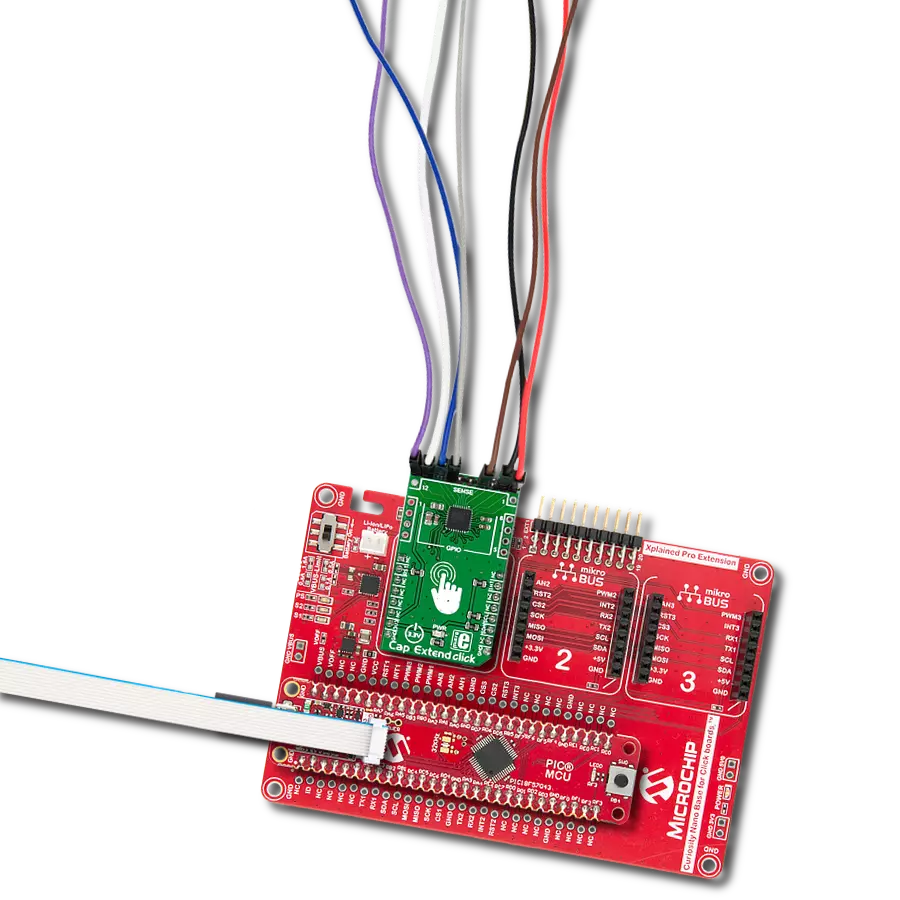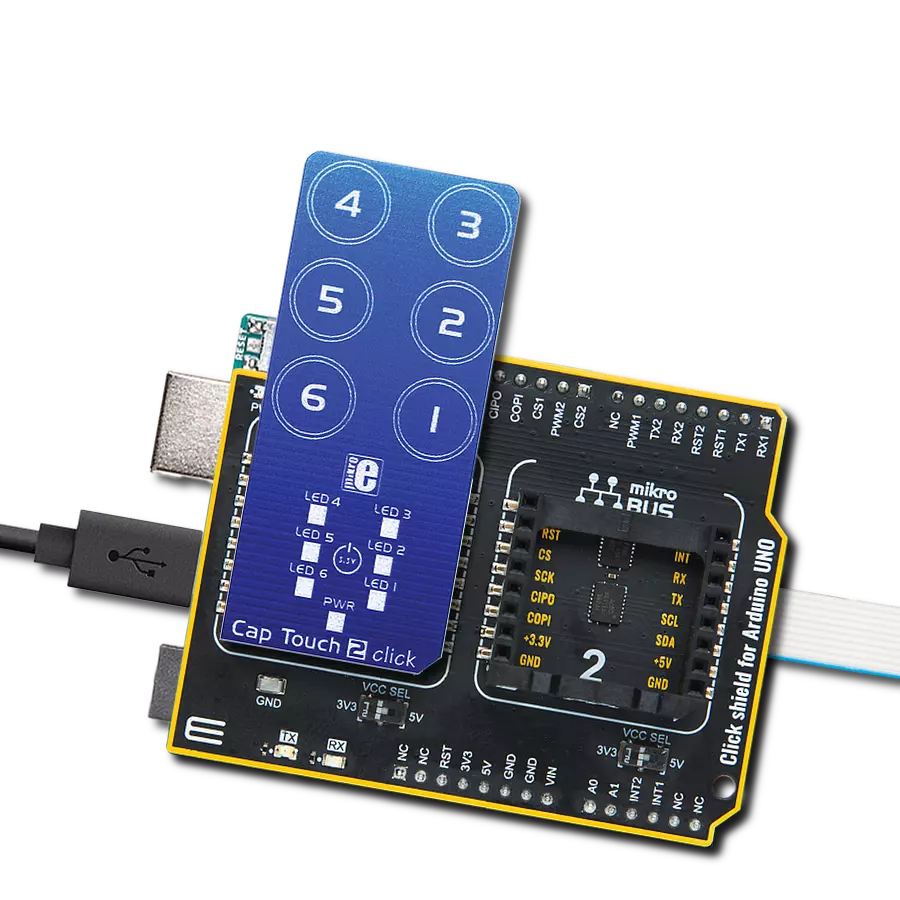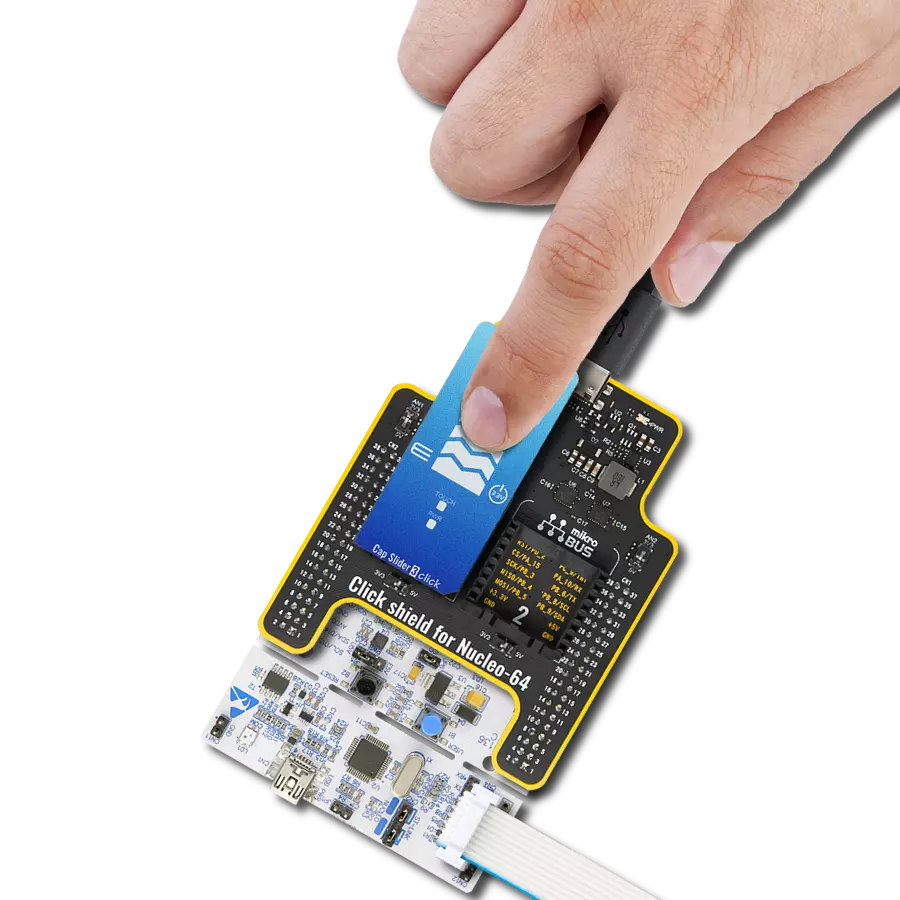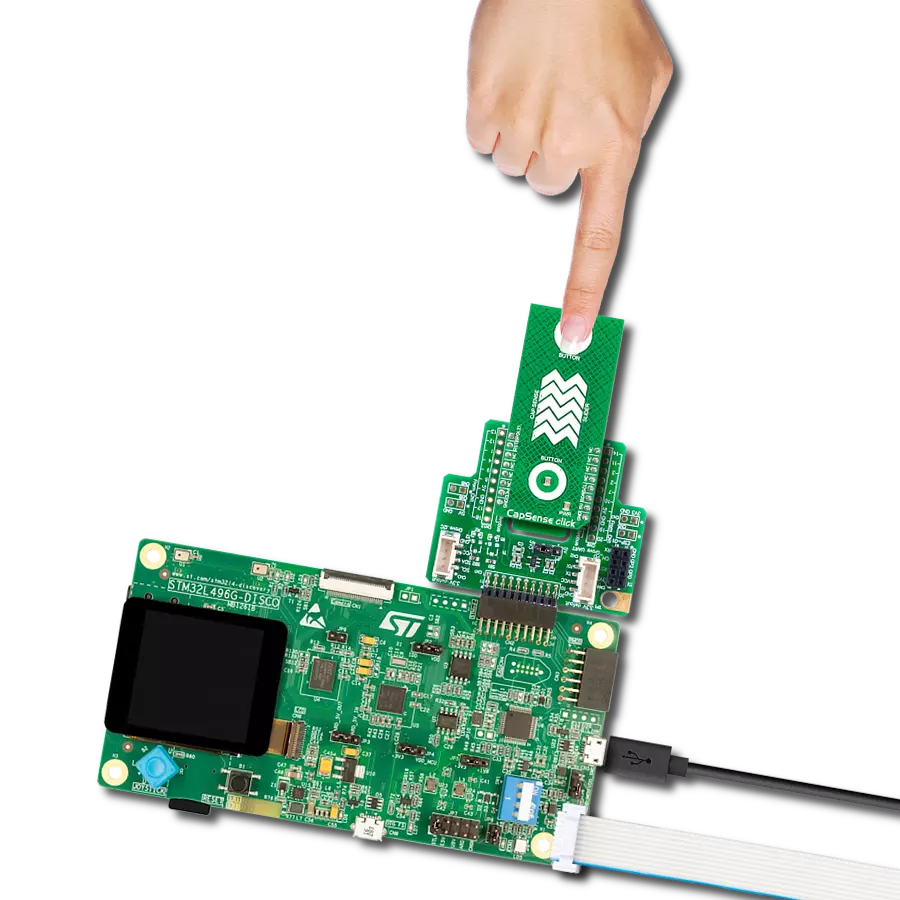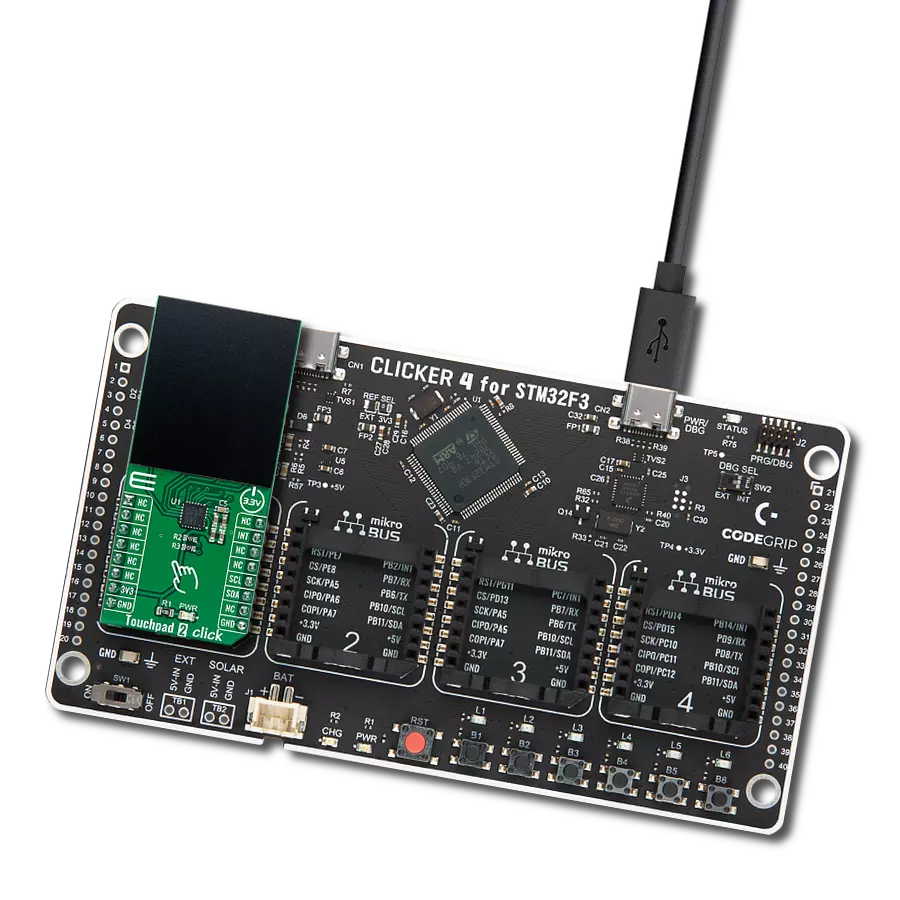Shape the future of interaction and engineer solutions that captivate and empower users
A
A
Hardware Overview
How does it work?
Cap Extend Click is based on the SX8633, a low-power capacitive button touch controller with enhanced LED drivers and proximity sensing from Semtech. It is a fully integrated 12-channel solution that requires no external components. The SX8633 IC has a 10-bit ADC and up to 100pF offset capacitance compensation at full sensitivity. Thanks to the high resolution, it supports a wide variety of touchpad sizes and shapes to be used with this Click board™. An overlay material up to 5mm thick can also be used for extremely robust ESD immune system design, simplifying integration into touch panels, control units, and similar applications. The SX8633 features auto offset calibration to eliminate false triggers due to temperature and humidity and is initiated on power-up. The principle of touch buttons and proximity sensing operation is almost identical. The only difference is that proximity sensing is done several centimeters through the air above the overlay, while as a button, it has an ON state if
a finger or hand touches it and OFF if it is far from the sensor. The Analog Sensing Interface (ASI) converts the sensors' charge into digitally processed ticks in both applications. The ASI consists of an ADC, DAC, multiplexer, analog switches, a reference voltage, and an external integration capacitor. In LED applications, the Auto-light mode can initiate the LED fade effect individually for each GPIO, with 256 PWM steps of linear and logarithmic control. The SX8633 has three operating modes. The Active mode has fast scan periods with a typical reaction time of up to 30ms, in which interval all enabled sensors are scanned, and data is processed. The Doze mode can increase scan period time, thus and the reaction time up to 195ms. In Sleep mode, the SX8633 goes OFF except for the communication interface and GPI peripheral, at which time it does not do any sensor scanning. Users can manipulate those scan periods for Active and Doze modes in relation to power consumption. To enter the Active
mode from Doze, the user can simply touch any button. The Cap Extend Click uses an I2C 2-Wire interface in standard and fast mode with a maximum clock frequency of 400KHz to communicate with the host microcontroller. The interrupt INT pin is also available and is updated in Active or Doze once every scan period. The interrupt will be asserted when a button event or a GPI edge occurs when entering Active or Doze and will be cleared as soon as the host MCU performs a read. In addition, there is an RST pin for resetting the SX8633 with active LOW. This Click board™ can be operated only with a 3.3V logic voltage level. The board must perform appropriate logic voltage level conversion before using MCUs with different logic levels. Also, it comes equipped with a library containing functions and an example code that can be used, as a reference, for further development.
Features overview
Development board
Nucleo 32 with STM32F031K6 MCU board provides an affordable and flexible platform for experimenting with STM32 microcontrollers in 32-pin packages. Featuring Arduino™ Nano connectivity, it allows easy expansion with specialized shields, while being mbed-enabled for seamless integration with online resources. The
board includes an on-board ST-LINK/V2-1 debugger/programmer, supporting USB reenumeration with three interfaces: Virtual Com port, mass storage, and debug port. It offers a flexible power supply through either USB VBUS or an external source. Additionally, it includes three LEDs (LD1 for USB communication, LD2 for power,
and LD3 as a user LED) and a reset push button. The STM32 Nucleo-32 board is supported by various Integrated Development Environments (IDEs) such as IAR™, Keil®, and GCC-based IDEs like AC6 SW4STM32, making it a versatile tool for developers.
Microcontroller Overview
MCU Card / MCU

Architecture
ARM Cortex-M0
MCU Memory (KB)
32
Silicon Vendor
STMicroelectronics
Pin count
32
RAM (Bytes)
4096
You complete me!
Accessories
Click Shield for Nucleo-32 is the perfect way to expand your development board's functionalities with STM32 Nucleo-32 pinout. The Click Shield for Nucleo-32 provides two mikroBUS™ sockets to add any functionality from our ever-growing range of Click boards™. We are fully stocked with everything, from sensors and WiFi transceivers to motor control and audio amplifiers. The Click Shield for Nucleo-32 is compatible with the STM32 Nucleo-32 board, providing an affordable and flexible way for users to try out new ideas and quickly create prototypes with any STM32 microcontrollers, choosing from the various combinations of performance, power consumption, and features. The STM32 Nucleo-32 boards do not require any separate probe as they integrate the ST-LINK/V2-1 debugger/programmer and come with the STM32 comprehensive software HAL library and various packaged software examples. This development platform provides users with an effortless and common way to combine the STM32 Nucleo-32 footprint compatible board with their favorite Click boards™ in their upcoming projects.
Used MCU Pins
mikroBUS™ mapper
Take a closer look
Click board™ Schematic

Step by step
Project assembly
Track your results in real time
Application Output
1. Application Output - In Debug mode, the 'Application Output' window enables real-time data monitoring, offering direct insight into execution results. Ensure proper data display by configuring the environment correctly using the provided tutorial.

2. UART Terminal - Use the UART Terminal to monitor data transmission via a USB to UART converter, allowing direct communication between the Click board™ and your development system. Configure the baud rate and other serial settings according to your project's requirements to ensure proper functionality. For step-by-step setup instructions, refer to the provided tutorial.

3. Plot Output - The Plot feature offers a powerful way to visualize real-time sensor data, enabling trend analysis, debugging, and comparison of multiple data points. To set it up correctly, follow the provided tutorial, which includes a step-by-step example of using the Plot feature to display Click board™ readings. To use the Plot feature in your code, use the function: plot(*insert_graph_name*, variable_name);. This is a general format, and it is up to the user to replace 'insert_graph_name' with the actual graph name and 'variable_name' with the parameter to be displayed.

Software Support
Library Description
This library contains API for Cap Extend Click driver.
Key functions:
capextend_reset- This function does a software reset of the click modulecapextend_read_msb_buttons- This function reads the MSB button map datacapextend_read_lsb_buttons- This function reads the LSB button map data
Open Source
Code example
The complete application code and a ready-to-use project are available through the NECTO Studio Package Manager for direct installation in the NECTO Studio. The application code can also be found on the MIKROE GitHub account.
/*!
* \file
* \brief CapExtend Click example
*
* # Description
* This example showcases the initialization and configuration of the logger and Click modules
* and later on shows how to read and display the 16-bit button map ( LSB + MSB ).
*
* The demo application is composed of two sections :
*
* ## Application Init
* This function initializes and configures the Click and logger modules.
*
* ## Application Task
* This function collects map data and displays the 16-bit button map, where each bit that has
* the value 1 represents a button that has been pressed.
*
* \author MikroE Team
*
*/
// ------------------------------------------------------------------- INCLUDES
#include "board.h"
#include "log.h"
#include "capextend.h"
// ------------------------------------------------------------------ VARIABLES
static capextend_t capextend;
static log_t logger;
// ------------------------------------------------------ APPLICATION FUNCTIONS
void application_init ( )
{
log_cfg_t log_cfg;
capextend_cfg_t cfg;
/**
* Logger initialization.
* Default baud rate: 115200
* Default log level: LOG_LEVEL_DEBUG
* @note If USB_UART_RX and USB_UART_TX
* are defined as HAL_PIN_NC, you will
* need to define them manually for log to work.
* See @b LOG_MAP_USB_UART macro definition for detailed explanation.
*/
LOG_MAP_USB_UART( log_cfg );
log_init( &logger, &log_cfg );
log_info( &logger, "---- Application Init ----" );
// Click initialization.
capextend_cfg_setup( &cfg );
CAPEXTEND_MAP_MIKROBUS( cfg, MIKROBUS_1 );
capextend_init( &capextend, &cfg );
capextend_reset( &capextend );
}
void application_task ( )
{
uint16_t buttons = 0;
buttons = capextend_read_buttons( &capextend );
log_printf( &logger, " * ---------BUTTTONS--------- * \r\n" );
for ( uint8_t counter = 0; counter < 12; counter++ )
{
if ( ( buttons >> ( 11 - counter ) ) & 1 )
{
log_printf( &logger, " * " );
}
else
{
log_printf( &logger, " o " );
}
}
log_printf( &logger, "\r\n * ------------------------------- * \r\n\r\n" );
Delay_ms ( 500 );
}
int main ( void )
{
/* Do not remove this line or clock might not be set correctly. */
#ifdef PREINIT_SUPPORTED
preinit();
#endif
application_init( );
for ( ; ; )
{
application_task( );
}
return 0;
}
// ------------------------------------------------------------------------ END






















